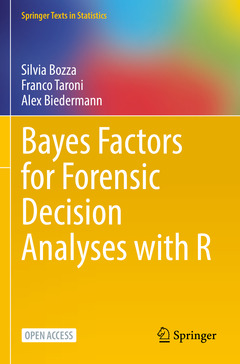Bayes Factors for Forensic Decision Analyses with R, 1st ed. 2022 Springer Texts in Statistics Series
Auteurs : Bozza Silvia, Taroni Franco, Biedermann Alex

Bayes Factors for Forensic Decision Analyses with R provides a self-contained introduction to computational Bayesian statistics using R. With its primary focus on Bayes factors supported by data sets, this book features an operational perspective, practical relevance, and applicability?keeping theoretical and philosophical justifications limited. It offers a balanced approach to three naturally interrelated topics:
- Probabilistic Inference - Relies on the core concept of Bayesian inferential statistics, to help practicing forensic scientists in the logical and balanced evaluation of the weight of evidence.
- Decision Making - Features how Bayes factors are interpreted in practical applications to help address questions of decision analysis involving the use of forensic science in the law.
- Operational Relevance - Combines inference and decision, backed up with practical examples and complete sample code in R, including sensitivity analyses and discussion on how to interpret results in context.
Over the past decades, probabilistic methods have established a firm position as a reference approach for the management of uncertainty in virtually all areas of science, including forensic science, with Bayes' theorem providing the fundamental logical tenet for assessing how new information?scientific evidence?ought to be weighed. Central to this approach is the Bayes factor, which clarifies the evidential meaning of new information, by providing a measure of the change in the odds in favor of a proposition of interest, when going from the prior to the posterior distribution. Bayes factors should guide the scientist's thinking about the value of scientific evidence and form the basis of logical and balanced reporting practices, thus representing essential foundations for rational decision making under uncertainty.
This book would be relevant to students, practitioners, and applied statisticians interested in inference and decision analyses in the critical field of forensic science. It could be used to support practical courses on Bayesian statistics and decision theory at both undergraduate and graduate levels, and will be of equal interest to forensic scientists and practitioners of Bayesian statistics for driving their evaluations and the use of R for their purposes.
This book is Open Access.
- clarify the different roles (known as, respectively, the ‘investigative’ and ‘evaluative’ role) that forensic scientists may assume in their daily work
- articulate the reasons why forensic scientists should adhere to a Bayesian framework of inference in order to ensure coherence in their inferential and decision-making tasks
- formally describe what the Bayes factor is and how it relates to coherent decision analysis
- describe the advantages that Bayes factors offer in assessing, articulating and communicating the value of scientific evidence in general, and in legal proceedings in particular
Emphasizes the role of Bayes factor guided reasoning as a necessary preliminary to coherent decision analysis
Presents computational details and interpretation of output, recommended in forensic science
Demonstrates how to tackle practical problems and discusses in detail, so readers can analyze their own data
This book is open access, which means that you have free and unlimited access.
Date de parution : 11-2023
Ouvrage de 187 p.
15.5x23.5 cm
Disponible chez l'éditeur (délai d'approvisionnement : 15 jours).
Prix indicatif 42,19 €
Ajouter au panierDate de parution : 11-2022
Ouvrage de 187 p.
15.5x23.5 cm
Disponible chez l'éditeur (délai d'approvisionnement : 15 jours).
Prix indicatif 52,74 €
Ajouter au panier


